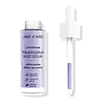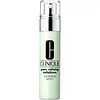What's inside
What's inside
 Key Ingredients
Key Ingredients

 Benefits
Benefits

 Concerns
Concerns

 Ingredients Side-by-side
Ingredients Side-by-side

Water
Skin ConditioningGlycerin
HumectantAlcohol Denat.
AntimicrobialIsopentyldiol
HumectantRosa Damascena Flower Water
MaskingPEG-40 Hydrogenated Castor Oil
EmulsifyingPhenoxyethanol
PreservativePolyacrylate Crosspolymer-6
Emulsion StabilisingCaprylyl Glycol
EmollientEthylhexylglycerin
Skin ConditioningHexylene Glycol
EmulsifyingButylene Glycol
HumectantCamellia Sinensis Leaf Extract
AntimicrobialHydroxypropyl Cyclodextrin
MaskingRibes Nigrum Seed Oil
EmollientOctyldodecanol
EmollientLavandula Hybrida Oil
EmollientLeuconostoc Ferment Filtrate
AntimicrobialCarthamus Tinctorius Seed Oil
MaskingOctyldodecyl Oleate
EmollientPropylene Glycol
HumectantDimethicone
EmollientAroma
Sodium Acrylates Crosspolymer-2
AbsorbentOctyldodecyl Stearoyl Stearate
EmollientCaprylic/Capric Triglyceride
MaskingCichorium Intybus Root Extract
MaskingBakuchiol
AntimicrobialLavandula Angustifolia Flower Extract
CleansingAlcohol
AntimicrobialIodopropynyl Butylcarbamate
PreservativeHydrolyzed Opuntia Ficus-Indica Flower Extract
AbrasiveT-Butyl Alcohol
PerfumingPolysilicone-11
Paeonia Suffruticosa Root Extract
Skin ProtectingSorbitol
HumectantHylocereus Undatus Fruit Extract
Skin ConditioningRosmarinus Officinalis Leaf Extract
AntimicrobialSolidago Virgaurea Extract
Skin ConditioningOligopeptide-68
BleachingDecyl Glucoside
CleansingGlycine Soja Oil
EmollientHydrogenated Lecithin
EmulsifyingTocopheryl Acetate
AntioxidantAscorbic Acid
AntioxidantSodium Oleate
CleansingDisodium EDTA
CI 77891
Cosmetic ColorantCI 16035
Cosmetic ColorantMica
Cosmetic ColorantCI 17200
Cosmetic ColorantCI 42090
Cosmetic ColorantWater, Glycerin, Alcohol Denat., Isopentyldiol, Rosa Damascena Flower Water, PEG-40 Hydrogenated Castor Oil, Phenoxyethanol, Polyacrylate Crosspolymer-6, Caprylyl Glycol, Ethylhexylglycerin, Hexylene Glycol, Butylene Glycol, Camellia Sinensis Leaf Extract, Hydroxypropyl Cyclodextrin, Ribes Nigrum Seed Oil, Octyldodecanol, Lavandula Hybrida Oil, Leuconostoc Ferment Filtrate, Carthamus Tinctorius Seed Oil, Octyldodecyl Oleate, Propylene Glycol, Dimethicone, Aroma, Sodium Acrylates Crosspolymer-2, Octyldodecyl Stearoyl Stearate, Caprylic/Capric Triglyceride, Cichorium Intybus Root Extract, Bakuchiol, Lavandula Angustifolia Flower Extract, Alcohol, Iodopropynyl Butylcarbamate, Hydrolyzed Opuntia Ficus-Indica Flower Extract, T-Butyl Alcohol, Polysilicone-11, Paeonia Suffruticosa Root Extract, Sorbitol, Hylocereus Undatus Fruit Extract, Rosmarinus Officinalis Leaf Extract, Solidago Virgaurea Extract, Oligopeptide-68, Decyl Glucoside, Glycine Soja Oil, Hydrogenated Lecithin, Tocopheryl Acetate, Ascorbic Acid, Sodium Oleate, Disodium EDTA, CI 77891, CI 16035, Mica, CI 17200, CI 42090
Dimethicone
EmollientWater
Skin ConditioningPolysilicone-11
Alcohol Denat.
AntimicrobialAcetyl Glucosamine
Skin ConditioningPEG-10 Dimethicone
Skin ConditioningButylene Glycol
HumectantRosmarinus Officinalis Leaf Extract
AntimicrobialSigesbeckia Orientalis Extract
Skin ConditioningSalvia Sclarea Extract
AntiseborrhoeicSea Whip Extract
Skin ConditioningLaminaria Saccharina Extract
Skin ProtectingCaffeine
Skin ConditioningPantethine
EmollientHydrolyzed Soy Protein
HumectantPEG-11 Methyl Ether Dimethicone
EmulsifyingAlgae Extract
EmollientPolysorbate 20
EmulsifyingSalicylic Acid
MaskingTetrahexyldecyl Ascorbate
AntioxidantTocopheryl Acetate
AntioxidantCaprylyl Glycol
EmollientSodium Hyaluronate
HumectantGlycerin
HumectantLecithin
EmollientIsohexadecane
EmollientDi-C12-18 Alkyl Dimonium Chloride
Skin ConditioningPolysorbate 80
EmulsifyingHydrogenated Lecithin
EmulsifyingPolymethyl Methacrylate
Coconut Acid
CleansingPadina Pavonica Thallus Extract
Skin ConditioningNordihydroguaiaretic Acid
AntioxidantAmmonium Acryloyldimethyltaurate/Vp Copolymer
Acrylamide/Sodium Acryloyldimethyltaurate Copolymer
Emulsion StabilisingSilica
AbrasiveCitric Acid
BufferingHexylene Glycol
EmulsifyingAscorbyl Tocopheryl Maleate
AntioxidantSodium Hydroxide
BufferingDisodium EDTA
Phenoxyethanol
PreservativeCI 77891
Cosmetic ColorantIron Oxides
Mica
Cosmetic ColorantDimethicone, Water, Polysilicone-11, Alcohol Denat., Acetyl Glucosamine, PEG-10 Dimethicone, Butylene Glycol, Rosmarinus Officinalis Leaf Extract, Sigesbeckia Orientalis Extract, Salvia Sclarea Extract, Sea Whip Extract, Laminaria Saccharina Extract, Caffeine, Pantethine, Hydrolyzed Soy Protein, PEG-11 Methyl Ether Dimethicone, Algae Extract, Polysorbate 20, Salicylic Acid, Tetrahexyldecyl Ascorbate, Tocopheryl Acetate, Caprylyl Glycol, Sodium Hyaluronate, Glycerin, Lecithin, Isohexadecane, Di-C12-18 Alkyl Dimonium Chloride, Polysorbate 80, Hydrogenated Lecithin, Polymethyl Methacrylate, Coconut Acid, Padina Pavonica Thallus Extract, Nordihydroguaiaretic Acid, Ammonium Acryloyldimethyltaurate/Vp Copolymer, Acrylamide/Sodium Acryloyldimethyltaurate Copolymer, Silica, Citric Acid, Hexylene Glycol, Ascorbyl Tocopheryl Maleate, Sodium Hydroxide, Disodium EDTA, Phenoxyethanol, CI 77891, Iron Oxides, Mica
Ingredients Explained
These ingredients are found in both products.
Ingredients higher up in an ingredient list are typically present in a larger amount.
Alcohol Denat. is an alcohol with a denaturant property. It is created by mixing ethanol with other additives.
This ingredient gets a bad rep because it is irritating and drying - mostly due to its astringent property. Astringents draw out natural oils in tissue, constricting pores and leaving your skin dried out.
However, alcohol denat. is not all that bad.
Due to its low molecular weight, alcohol denat. tends to evaporate quickly. One study on pig skin found half of applied alcohol evaporated in 10 seconds and less than 3% stayed on skin.
This also helps other ingredients become better absorbed upon application.
Studies are conflicted about whether this ingredient causes skin dehydration. One study from 2005 found adding emollients to propanol-based sanitizer decreased skin dryness and irritation. Another study found irritation only occurs if your skin is already damaged.
Small amounts of alcohol are generally tolerated by oily skin or people who live in humid environments.
The rule of thumb is if this alcohol is near the end of an ingredients list, it will probably not affect your skin much.
Also...
This ingredient has antimicrobial and solvent properties.
The antimicrobial property helps preserve products and increase their shelf life. As a solvent, it helps dissolve other ingredients.
Other types of astringent alcohols include:
Learn more about Alcohol Denat.Butylene Glycol (or BG) is used within cosmetic products for a few different reasons:
Overall, Butylene Glycol is a safe and well-rounded ingredient that works well with other ingredients.
Though this ingredient works well with most skin types, some people with sensitive skin may experience a reaction such as allergic rashes, closed comedones, or itchiness.
Learn more about Butylene GlycolCaprylyl Glycol is a humectant and emollient, meaning it attracts and preserves moisture.
It is a common ingredient in many products, especially those designed to hydrate skin. The primary benefits are retaining moisture, skin softening, and promoting a healthy skin barrier.
Though Caprylyl Glycol is an alcohol derived from fatty acids, it is not the kind that can dry out skin.
This ingredient is also used as a preservative to extend the life of products. It has slight antimicrobial properties.
Learn more about Caprylyl GlycolCi 77891 is a white pigment from Titanium dioxide. It is naturally found in minerals such as rutile and ilmenite.
It's main function is to add a white color to cosmetics. It can also be mixed with other colors to create different shades.
Ci 77891 is commonly found in sunscreens due to its ability to block UV rays.
Learn more about CI 77891Dimethicone is a type of synthetic silicone created from natural materials such as quartz.
What it does:
Dimethicone comes in different viscosities:
Depending on the viscosity, dimethicone has different properties.
Ingredients lists don't always show which type is used, so we recommend reaching out to the brand if you have questions about the viscosity.
This ingredient is unlikely to cause irritation because it does not get absorbed into skin. However, people with silicone allergies should be careful about using this ingredient.
Note: Dimethicone may contribute to pilling. This is because it is not oil or water soluble, so pilling may occur when layered with products. When mixed with heavy oils in a formula, the outcome is also quite greasy.
Learn more about DimethiconeDisodium EDTA plays a role in making products more stable by aiding other preservatives.
It is a chelating agent, meaning it neutralizes metal ions that may be found in a product.
Disodium EDTA is a salt of edetic acid and is found to be safe in cosmetic ingredients.
Learn more about Disodium EDTAGlycerin is already naturally found in your skin. It helps moisturize and protect your skin.
A study from 2016 found glycerin to be more effective as a humectant than AHAs and hyaluronic acid.
As a humectant, it helps the skin stay hydrated by pulling moisture to your skin. The low molecular weight of glycerin allows it to pull moisture into the deeper layers of your skin.
Hydrated skin improves your skin barrier; Your skin barrier helps protect against irritants and bacteria.
Glycerin has also been found to have antimicrobial and antiviral properties. Due to these properties, glycerin is often used in wound and burn treatments.
In cosmetics, glycerin is usually derived from plants such as soybean or palm. However, it can also be sourced from animals, such as tallow or animal fat.
This ingredient is organic, colorless, odorless, and non-toxic.
Glycerin is the name for this ingredient in American English. British English uses Glycerol/Glycerine.
Learn more about GlycerinHexylene Glycol is a surfactant. Glycols are a class of alcohols. Hexylene Glycol is a surfactant and emulsifier.
As a surfactant, Hexylene Glycol helps gather dirt and oil on your skin to be washed away.
As an emulsifier, Hexylene Glycol helps keep water and oil together. This prevents them from separating in a product. Hexylene Glycol also thins out the texture of a product by lessening viscosity.
Hexylene Glycol has a small molecular weight.
Learn more about Hexylene GlycolHydrogenated Lecithin is created from the hydrogenation of lecithin (a group of phospholipids). Hydrogenation is a chemical reaction between hydrogen and another element.
This ingredient is an emollient and emulsifier. As an emollient, it helps soften skin by trapping moisture within. As an emulsifier, it prevents oil and water ingredients from separating.
Mica is a naturally occurring mineral used to add shimmer and color in cosmetics. It can also help improve the texture of a product or give it an opaque, white/silver color.
Serecite is the name for very fine but ragged grains of mica.
This ingredient is often coated with metal oxides like titanium dioxide. Trace amounts of heavy metals may be found in mica, but these metals are not harmful in our personal products.
Mica has been used since prehistoric times throughout the world. Ancient Egyptian, Indian, Greek, Roman, Aztec, and Chinese civilizations have used mica.
Learn more about MicaPhenoxyethanol is a preservative that has germicide, antimicrobial, and aromatic properties. Studies show that phenoxyethanol can prevent microbial growth. By itself, it has a scent that is similar to that of a rose.
It's often used in formulations along with Caprylyl Glycol to preserve the shelf life of products.
Polysilicone-11 is a film-forming silicone that creates a non-tacky and matte finish on the skin. It's commonly used to improve texture, absorb excess oil, and help active ingredients spread evenly.
Due to its "rubber-like" structure, it stays on the skin's surface instead of being absorbed. On the skin, it creates a flexible layer that enhances wearability and stability.
Rosmarinus Officinalis Leaf Extract comes from rosemary. Rosemary is native to the Mediterranean.
While Rosmarinus Officinalis Leaf Oil can be volatile due to its fragrant properties, the fragrance components are usually removed in the leaf extract.
Rosemary Leaf Extract contains many antioxidants such as rosmarinic acid and caffeic acid. Rosemarinic acid, a compound found in rosemary leaf, has been found to help soothe skin conditions such as eczema and acne.
Learn more about Rosmarinus Officinalis Leaf ExtractTocopheryl Acetate is AKA Vitamin E. It is an antioxidant and protects your skin from free radicals. Free radicals damage the skin by breaking down collagen.
One study found using Tocopheryl Acetate with Vitamin C decreased the number of sunburned cells.
Tocopheryl Acetate is commonly found in both skincare and dietary supplements.
Learn more about Tocopheryl AcetateWater. It's the most common cosmetic ingredient of all. You'll usually see it at the top of ingredient lists, meaning that it makes up the largest part of the product.
So why is it so popular? Water most often acts as a solvent - this means that it helps dissolve other ingredients into the formulation.
You'll also recognize water as that liquid we all need to stay alive. If you see this, drink a glass of water. Stay hydrated!
Learn more about Water